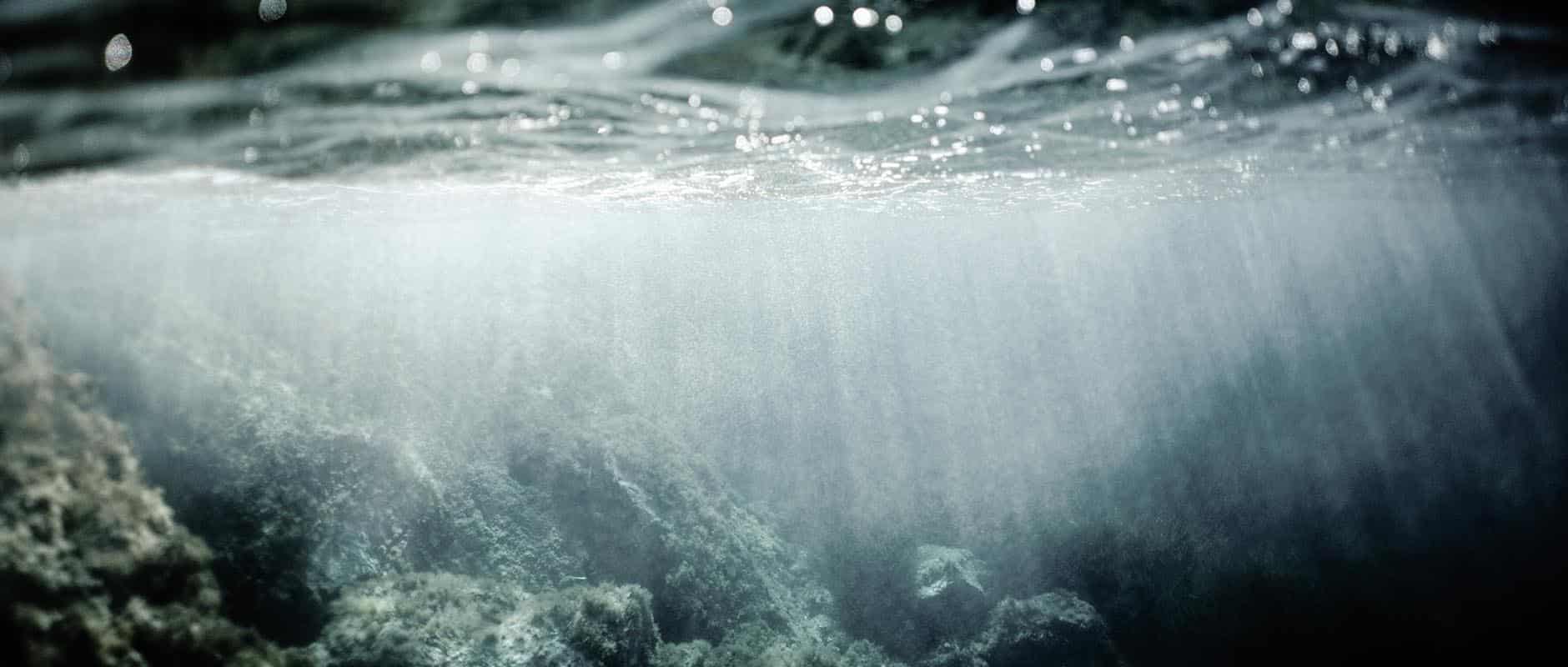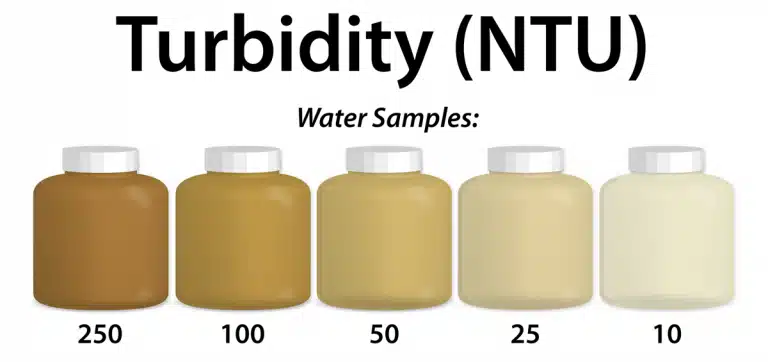- Turbidity and TSS are two separate but comparable measurements of water clarity.
- Turbidity is determined by evaluating the light-scattering qualities of the water and determining how clear or translucent it is.
- TSS refers to any particles suspended in the water column, including silt, algae, sediment, other solids, and other substances (both organic and inorganic). Unlike TSS, dissolved solids, such as salts and minerals that are fully dissolved in water. However, these are not included in TSS measurements and are instead measured as total dissolved solids (TDS).
Turbidity and TSS are two distinct yet interconnected measurements related to water clarity. Researchers frequently use terms like turbidity and total suspended solids (TSS) to describe water quality. However, it’s essential to clarify the differences between these two parameters. While both offer insights into water clarity, they have distinct characteristics and measurement methods. Both turbidity and TSS are typically measured from a water sample collected from the body of water to ensure accurate assessment of these parameters.
Introduction to Water Quality
Water quality plays a vital role in sustaining healthy aquatic ecosystems and supporting the well-being of both wildlife and humans. Among the most important indicators of water quality are turbidity and total suspended solids (TSS). Turbidity describes the cloudiness or haziness of a body of water, which results from the presence of suspended particles such as clay, silt, and organic matter. In contrast, total suspended solids measure the actual concentration of these particles suspended in the water column. Understanding the relationship between turbidity and total suspended solids is essential for effective water quality management, as both parameters influence the health of aquatic life and the overall condition of water bodies. Regulatory agencies, like the Minnesota Pollution Control Agency, set standards for TSS and turbidity to protect lakes, rivers, and streams.
Understanding Suspended Solids
Suspended solids are a diverse mix of particles that remain dispersed throughout the water column, including both organic and inorganic particles such as sediment, algae, and even industrial waste. These suspended solids can significantly affect water quality by reducing light penetration, which in turn inhibits photosynthesis and disrupts the growth of aquatic vegetation. The presence of suspended solids can also alter habitats for aquatic organisms, making it harder for fish and other species to thrive. Additionally, suspended solids can absorb and transport harmful pollutants like heavy metals and pesticides, posing further risks to aquatic life. In urban environments, sources of suspended solids often include soil erosion, urban runoff, and stormwater runoff, all of which can increase the concentration of these particles in local water bodies. Monitoring suspended solids concentration is therefore crucial for understanding how human activities and natural processes affect water quality and the health of aquatic ecosystems.
Turbidity & Water Quality
Turbidity is an optical parameter understood as a specific medium’s clarity. We can also refer to turbidity by examining the water’s light-scattering characteristics and determining how clear or translucent it is. The unit for measuring turbidity is a Nephelometric Turbidity Unit (NTU). Usually, a larger NTU score indicates more suspended solids, organic debris, algae, and other minute particles that cause the liquid to become hazy or murky are present. Researchers can identify the particles present by testing turbidity. Measured turbidity is an important indicator of water quality and the concentration of particles present.
Generally, higher NTU measurements suggest less clear water, whereas low readings indicate clearer liquid. NTU values typically range from 1 to 4000, with 1 denoting the purest clarity and 4000 denoting transparencies like milk. High turbidity levels (high NTU values) indicate the presence of many suspended particles and reduced water clarity. For example, a fairly good NTU reading for tap water would be less than 1. Researchers can measure turbidity in two ways: Turbidimetry or nephelometry. Both methods test and record light (of a known intensity) as it passes through a medium. Turbidimetry counts measure how much light is attenuated. In contrast, nephelometry measures how much light is scattered.
Total Suspended Solids (TSS)
Total suspended solids (TSS) include any particles suspended in the water column, like silt, algae, sediment, suspended sediments, organic material, organic particles, and other substances (both organic and inorganic). These particles can be separated from the water during the filtering process because they are big enough not to pass through the filter. Generally, suspended particles absorb heat from the sun, thus raising the water’s temperature when dissolved oxygen levels are too low. Conversely, if dissolved oxygen levels are too high, this can be fatal to aquatic life. Researchers measure TSS in mg/L, ppm, g/L, and %. Total suspended solids concentration is a key parameter for assessing pollution and ecosystem health.
A sample liquid must be filtered, dried, and weighed after filtering to determine TSS. This procedure is similar to the measurement of total solids, but focuses specifically on the suspended fraction Researchers can measure TSS with portable instruments. However, they can be fairly expensive. Generally, people regard Hach as the best metre for measuring TSS. Another good thing about these portable instruments is that they can also measure turbidity.
Turbidity Measurement Techniques
Measuring turbidity is a key practice for evaluating water clarity and detecting changes in water quality. The most common approach involves using nephelometric turbidity units (NTU), which quantify the amount of light scattered by suspended solids in the water. Nephelometry is the technique used to measure this scattered light, while turbidimetry focuses on the amount of light absorbed by the particles. Both methods provide valuable turbidity measurements that help water managers assess the presence and concentration of suspended particles. Turbidity monitoring can be performed with portable turbidimeters for fieldwork or with laboratory-based equipment for more detailed analysis. Regularly measuring turbidity is essential for tracking water clarity, identifying pollution sources, and ensuring that water bodies remain safe for aquatic life and human use.
Turbidity vs TSS
The primary purpose of turbidity monitoring is to assess water clarity. Highly turbid water is opaque and frequently called cloudy or murky; this appearance is due to a significant number of particles dispersed throughout the water. In this respect, turbidity and TSS relate to one another, yet it’s crucial to distinguish them despite their resemblance. Turbidity is solely a gauge of relative clarity. So, although it cannot precisely measure the solids, turbidity can show variations in the water’s TSS concentration.
Turbidity and TSS measurements are often taken during periods of high flow, such as after heavy rainfall or snowmelt, because these events can increase the amount of suspended particles in water. In most lakes, sources of turbidity and TSS often include shoreline erosion, phytoplankton, and decaying vegetation.
Although they don’t measure the same thing, TSS and turbidity are comparable because they both measure the liquid’s clarity. Determining turbidity from a sample enables you to obtain an immediate reading of NTUs. This allows you to take measurements while still in the field. On the other hand, TSS measurement is a laborious, manual operation that frequently necessitates making measurements back in a lab. As was already noted, portable metres are available, but they are expensive and may or may not be worthwhile investments depending on their intended use. Therefore, it is important to consider how frequently testing is necessary and whether testing may be performed off-site or in a laboratory for filtration. Suspended particles, especially darker ones, can absorb sunlight and cause the water to retain more heat, impacting aquatic life.
When measuring TSS and turbidity, heavier particles may settle out quickly or interfere with measurement instruments, presenting additional challenges for accurate readings.
Importance of determining both parameters
Turbidity measurement is beneficial and practical, even though it is an optical parameter. Determining suspended solids is one of the simplest and least expensive ways to assess a water source’s health. Discharges, erosion, runoff, algal blooms, or disturbed sediments are a few potential reasons for excessive turbidity. Suspended particles can enter a body of water in a variety of ways. These factors will impact a body of water. For example, high TSS levels in turbid water can raise water temperatures, lower dissolved oxygen levels, and inhibit photosynthesis, which can cause underwater plants to die off and disrupt the ecosystem’s food chain. Additionally, erosion and runoff cause the increase in contamination of a water body, resulting in toxic algal blooms.
TSS is a crucial indicator of water quality for wastewater treatment processes and environmental safety. Technicians must remove a significant amount of suspended organic and inorganic debris using filtering, settling, or flotation techniques before releasing wastewater into the environment.
Applications of Turbidity and TSS Measurement
Turbidity and TSS measurements are indispensable tools in water quality management across a variety of applications. In wastewater treatment plants, these measurements help operators monitor the removal of suspended solids and ensure compliance with environmental regulations. Researchers use turbidity measurements to assess the impact of stormwater runoff and algal blooms on receiving waters, providing early warnings of potential water quality issues. By estimating TSS concentrations from turbidity readings, water managers can calculate sedimentation rates and predict how suspended solids might affect aquatic ecosystems. These measurements are equally important for maintaining safe drinking water supplies, as high levels of suspended solids can compromise the taste, odor, and appearance of water. Overall, regular turbidity and TSS measurements are essential for protecting water quality and supporting the health of both natural and human communities.
Real-time Monitoring Solution
Water quality data contain critical facts to support decision-making in water resource management. Therefore, continuous, real-time data on water quality are essential to ensure sufficient water resources. In addition, higher data collecting frequency improves comprehension of the factors that affect water quality. LG Sonic technology uses the Monitoring Buoy that provides a complete overview of your water quality by collecting key parameters every 10 minutes. This integrated real-time water quality monitoring system can measure key water quality parameters, including TSS, Turbidity, and beyond.
Conclusion
In summary, turbidity and TSS are among the most visible indicators of water quality, offering critical insights into the health of aquatic environments. By regularly measuring turbidity and TSS, water managers can detect changes caused by excessive sedimentation, soil erosion, and urban runoff. These factors that often lead to increased turbidity and higher concentrations of suspended solids. These measurements are vital for identifying pollution sources, evaluating the effectiveness of treatment systems, and safeguarding aquatic life. As water quality challenges continue to grow, prioritizing turbidity monitoring and TSS measurements will help ensure the long-term health of our water bodies and the ecosystems they support. Comprehensive management strategies that address the root causes of increased turbidity and TSS are essential for maintaining clean, clear water for all.

